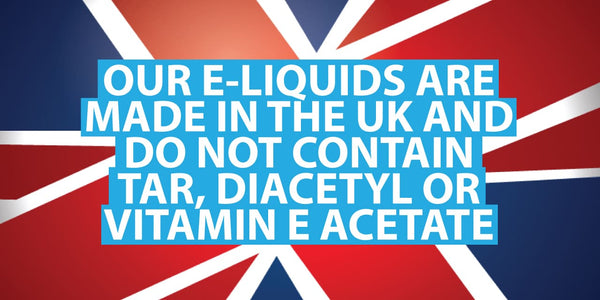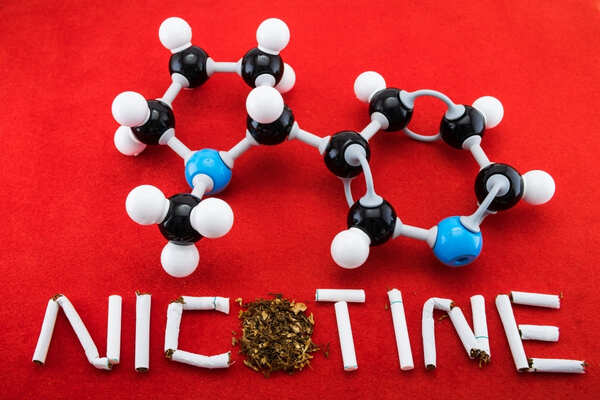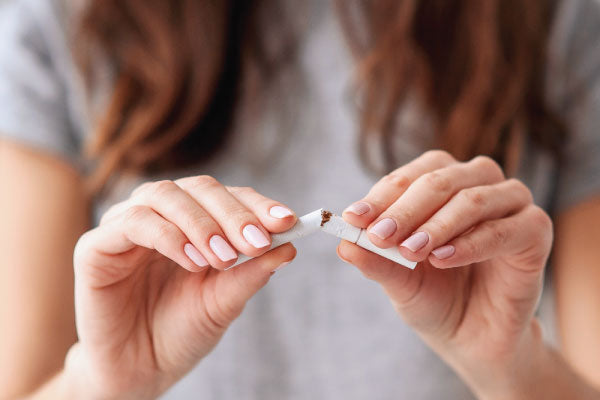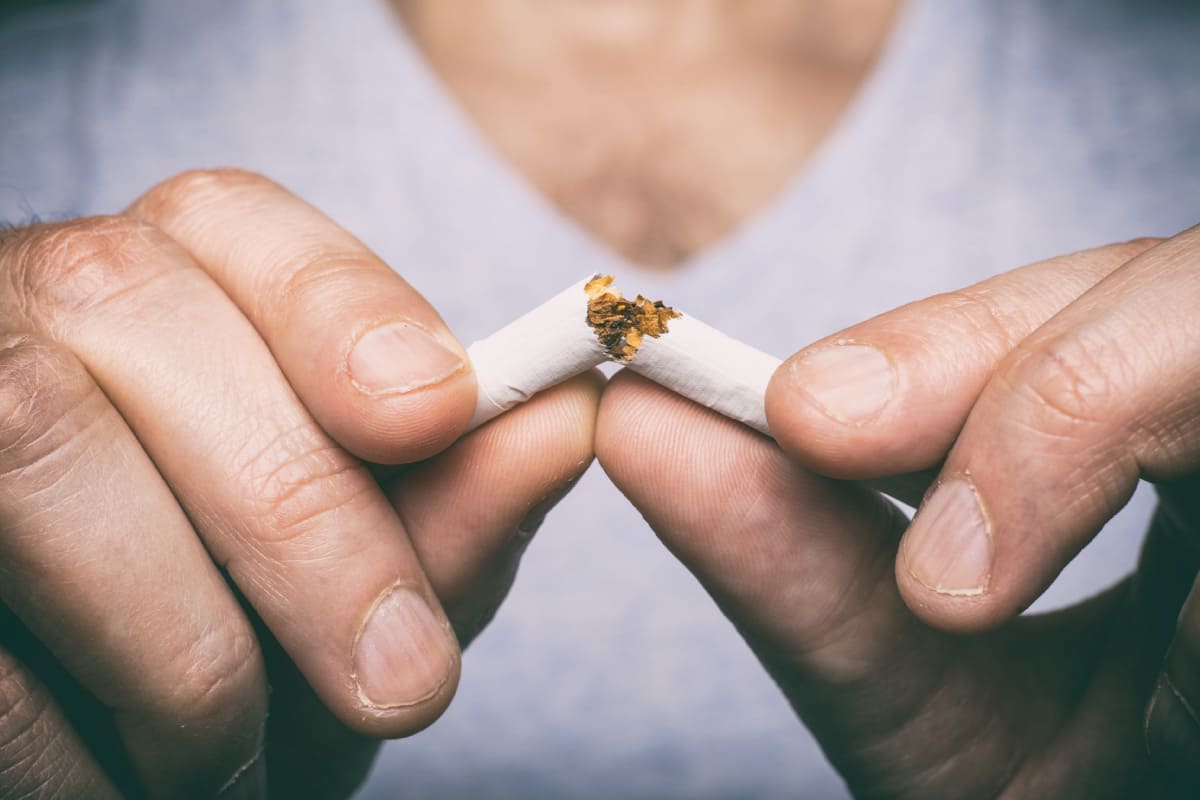WHAT IS IN VAPE JUICE
Vape juice or e-liquid has four ingredients: propylene glycol PG, vegetable glycerine VG, nicotine (unless it’s nicotine free) and flavourings.
The fact that there are only 4 ingredients in vape juice is the reason that it is 95% less harmful than tobacco, and why the vapour produced doesn't harm people around you like 2nd hand smoke does.
And of course as it has nicotine in it can help satisfy that addiction without having to take in the 5000+ cancer causing chemicals in tobacco!
The ratio of propylene glycol to vegetable glycerine varies as they contribute different things to the overall vape experience, PG increasing the throat hit where VG makes the inhale smoother. Different nicotine levels and different flavours are available and vape juice can be used in most vape kits.
WHAT IS VAPE JUICE
E-juice, e-liquid or vape juice, - it’s all the same thing, and that is a mixture of Propylene Glycol or PG, Vegetable Glycerin VG, flavourings, and the all-important nicotine!
There are a few variations on the contents of e-liquids - the PG VG balance, the flavourings, the level of nicotine, and the type of nicotine added. They all contribute to the vaping experience in different ways including the flavour, the amount of vapour produced and the throat hit the user experiences.
There are plenty of retailers that sell ready made e-liquids, and these are subject to the rules and regulations of the country of origin, but you can also buy the constituent parts and mix your own e-juice!
HOW IS E-LIQUID MADE
E-liquid is made by mixing Vegetable Glycerine (VG) and Propylene Glycol (PG) in the desired balance; many cig-a-like e-cigarettes use a 50/50 VG to PG balance which lends itself to a decent throat hit.
When you have your base mixture of VG to PG, you can add in your flavouring (if required). This should mean adding ten to twenty drops of your flavouring to the mixture. Then add your nicotine!
Here at SMOKO we are proud that all our E-liquids are made, tested and regulated in the UK. Though the UK has some of the most stringent laws around e-liquid, by making them here we can make sure that they are as safe as possible, while also give our customers a great flavour.
WHAT FLAVOURINGS ARE IN E-LIQUID
Flavoured e-juice makes the vaping experience enjoyable; the variety of flavours available means you can change it up if you ever get bored of a flavour.
Quality vape juice contains food grade flavourings in their mix, and regulation here in the UK keeps harmful additives, like diacetyl, from being added. Diacetyl was a flavouring that caused a lot of problems for the perception of vaping - inhaling it causes the condition known as ‘popcorn lung’ that was experienced by workers in a popcorn factory that used diacetyl to flavour the popcorn.
WHAT ARE PG AND VG
PG and VG are the base for e-liquids, and are used for many things, including as a food additive or a humectant (a substance that keeps things moist) for cosmetics.
Propylene glycol (PG) is a synthetic, colourless liquid that has almost no taste or smell with a syrup-like consistency. It is a great carrier for nutrients, colours and flavours!
Vegetable glycerine (VG) is another clear, odourless, syrupy liquid that has a sweet taste. It is typically made from coconut or palm oil, or soybean.
From what studies have shown, both PG and VG are harmless in E-Cigarettes.
E-liquids are made with varying balances of PG to VG for different vaping experiences, but in the rare case of having an allergy to PG, 100% VG vaping liquids are available. Users will require a more powerful vaping kit than a cig-a-like for use with these; a powerful vape pen or box mod is needed due to the viscosity of 100% VG liquids.
In the very rare case of an allergy to VG, 100% PG e-liquid can be used!
WHAT NICOTINE LEVELS ARE IN VAPE JUICE
Nicotine is the most significant ingredient in vape juice - it was a man from China named Hon Lik who invented the e-cigarette as a replacement for actual cigarettes, as a way to deliver nicotine in a similar fashion to smoking that was much less harmful. Nicotine itself is an organic compound found in the tobacco plant that acts as a pesticide.
Since the introduction of e-cigarettes to the retail market, there has not been international consensus on regulation. Here in the UK, the strongest e-liquid legally available to buy is 2% due to the TPD (Tobacco Products Directive) laws that came into affect in May 2016.
The nicotine content in your liquid will affect your vaping experience: higher nicotine levels increase the throat hit, a small amount of nicotine will reduce the throat hit. Making your e-liquid with nicotine salts (nic salts), instead of freebase nicotine, results in a much smoother inhale experience - so you can vape higher nicotine strengths without the harsh throat hit! However, if you are a heavier smoker looking for a realistic e-cigarettes, using a free-based nicotine e-liquid will be more effective in helping you switch to vaping!
Those vapers using e-cigarettes as a smoking cessation tool can reduce their nicotine consumption by using vape juice with progressively weaker nicotine concentrations over a period of time. With the option of nicotine free liquid, quitters and ex-smokers can still vape without feeding their nicotine addiction!
ARE E-LIQUID INGREDIENTS SAFE
In countries with regulation of e-cigarettes and other vaping products, the ingredients in e liquids are safe for vaping, with a fraction of the harmful chemicals found in cigarettes generated when the liquid is heated into an aerosol.
This aligns with the Royal College of Physicians conclusion that e-cigarettes would likely not exceed 5% of the damage done by tobacco products, which backs up Public Health England’s statement that e-cigarettes are around 95% less harmful than traditional tobacco products.
One study examined e-cigarette aerosol and found that the composition of exhaled aerosol was over 99.9% vegetable glycerine and water, suggesting that exhaled e-cigarette aerosol presents little risk of harm to by-standers.
The same study measured levels of machine generated e-cigarette aerosol and found that the levels of harmful compounds like acrolein and acetaldehyde produced by e-cigarettes were in line with background levels, again suggesting that e-cigarette aerosol presents little risk.
Compared with a traditional cigarette, e-cigarettes don’t passively burn. Once lit up, tobacco cigarettes burn while not being smoked, and this side stream accounts for around 85% of environmental tobacco smoke aerosol, indicating that ‘second hand vaping’ is not a serious risk.
It is worth noting that the option of flavourless e-liquids exists. Understandably, this will reduce the pleasure taken in the vaping experience, but there are subtle benefits to doing so. One study examined the development of oral bacteria after exposure to flavoured and unflavoured e-cigarette aerosol and found the flavoured option had a larger negative impact on the oral bacteria than its unflavoured counterpart.
WHAT TO LOOK FOR IN A QUALITY VAPE LIQUID
Good quality e-liquids should be readily available, the question is: how can you tell?
Countries with good levels of regulation for e-cigarettes are a good place to buy from, and checking reviews for a company before you buy from them should give you an idea of the level of customer service you can expect.
Here in the UK, manufacturers of e-liquids are required to submit their products for testing, details of which are then passed to the regulatory body, the MHRA.
Make sure to check out the company website, watch out for deals that are too good to be true, check the level of information available on the product and the company’s labelling practices - poor offerings here indicate that you may want to stay away.
WHAT EXACTLY IS IN VAPE JUICE?
Public Health England believes e-cigarette use to be 95% less harmful than smoking normal cigarettes. As smoking is the world’s largest cause of preventable death, less harmful options are a step in the right direction - vaping eliminates 95% of the harmful chemicals found in tobacco smoke, so it is a huge leap in the right direction.
Make sure to buy from trusted sources to ensure you are only putting approved, high quality ingredients into your body that have been subject to assessment by a regulatory body. If in doubt, buying UK made liquids is probably the safest bet you can make.
If you are still smoking and looking for an alternative that is less harmful, here is a range of popular e-cigarette and vape starter kits designed to help you to quit smoking!
REFERENCES
1) Public Health England's statement on the safety of E-Cigarettes compared to cigarettes
2) NHS on E-Cigarettes and the safety of 2nd hand vapour
3) Cancer Research UK article on the cancer causing chemicals in tobacco
4) UK Government report on Popcorn lung from E-Cigarettes
5) Study on the effect of PG and VG in E-Cigarettes
6) History of E-Cigarettes and the invention of the Vape
7) The Royal Collage of Physicians on the safety of E-Cigarettes
8) A study examining e-cigarette aerosol and the composition of exhaled aerosol was over 99.9% vegetable glycerine and water
9) Study on impact of E-Cigarettes on the oral bacteria
ABOUT THE AUTHOR
Dan Overgage – is a former smoker of 10 years until he became a client of SMOKO E-Cigarettes. Dan started working with SMOKO 5 years ago after successfully quitting using our e-cigarettes and works across our Customer Service and heads up our content creation and research with a strong focus on all things quitting smoking. During his tenure with SMOKO, Dan has written countless blogs and consults with countless clients every day to help them to stay smoke-free.















